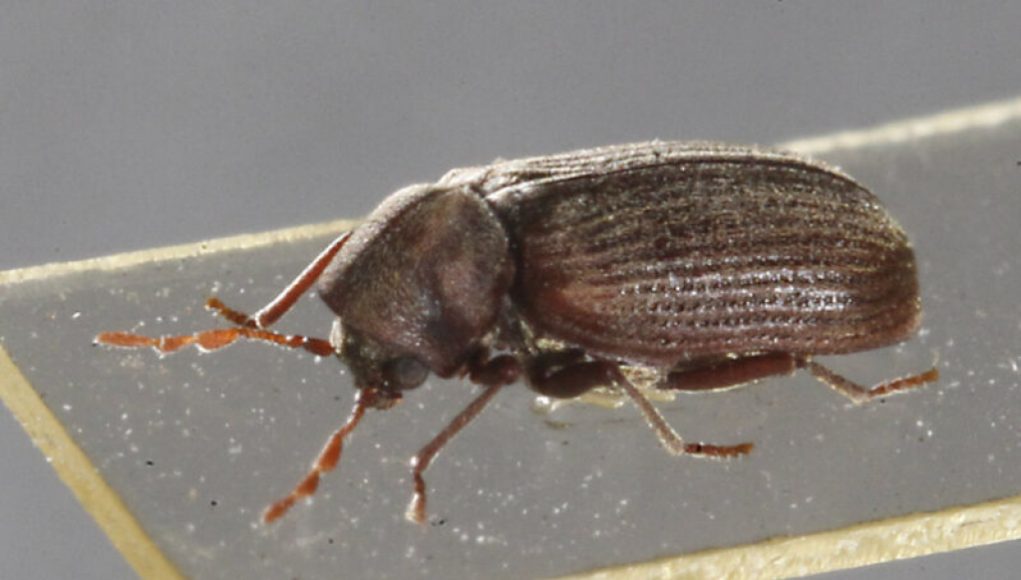Get ready to be grossed out! A couple in France developed a rare and “almost forgotten” disease after the beetles munching on their furniture developed their own infestation of toxin-toting mites. According to a case report published in the New England Journal of Medicine by doctors in Marseille, the man and woman turned up at an infectious disease clinic three days after developing an intensely itchy rash all over their abdomens. But what caused it? The answer may have gone undetermined if it weren’t for a telltale pattern of the woman’s rash. The itchy pink marks on her trunk had central dots with pink trails reminiscent of a comet. Comet-shaped rashes are a hallmark of the toxin-laden bites from the mite Pyemotes ventricosus, also known as the European straw itch mite. In fact, it’s called the “comet sign.”
But where do these mites come from? Well, they’re ectoparasites of the common furniture beetle, Anobium punctatum, a wood-boring beetle that devours wood-based furniture and structures. The mites have a truly disturbing life cycle on their chosen hosts. When a female bites a beetle larva, it injects a toxin to paralyze its prey, then sucks up its meal, engorging itself. The feeding allows the female to nourish up to 300 eggs in her abdomen, which fully develop there. A few days after the feeding, the female gives birth to adult mites that immediately mate and disperse to find new hosts, starting the process again. The males are not visible to the unaided eye, and the females can only barely be seen if they’re engorged.
If there aren’t enough beetles to feast upon, the mites will inadvertently bite mammals, such as horses, cattle, and humans. The mites can’t use these animals as hosts, but it doesn’t make their bites any less horrifying. In humans, the painless bites by the seemingly invisible mites develop over the course of about 24 hours into extremely itchy welts and pink marks. It’s not entirely clear what causes the comet sign, but it’s thought to be due to inflammation of a lymphatic channel around the bite.
Mites in the family Pyemotidae can parasitize a variety of insects and can be found in seeds, grain, straw, as well as wood, but such reports of Pyemotes dermatitis have popped up sporadically for well over a century. Pyemotes ventricosus was first described in 1850, though the first reported outbreak was only reported in 1909 among the crew of a private yacht, who slept on infested straw mattresses. Since then, there have been just around 20 outbreaks, according to a review published last year, as well as about 40 individual case reports.
The good news is that however gross and itchy, the mite bites are rare and not thought to transmit infectious diseases. The skin condition generally resolves on its own, though sometimes it can be accompanied by fever, chills, vomiting, and headaches, depending on how extent of the mite attack. In the couple’s case, they ditched their infested furniture and were treated with topical glucocorticoids and antihistamines. Their itchy lesions went away eight days later.
When it comes to home ownership, pests are a nightmare for any homeowner. Recently, a Louisiana couple discovered just how costly and far-reaching pest infestations can be in the most unexpected way. Kenneth and Catherine Stewart discovered their furniture was being eaten away after two furniture-eating beetle larvae were found in their home. This infestation was caused by an infestation of mites that carried a rare and potentially life-threatening type of fungus.
The furniture was brought in from a nearby antique store, and after a pest inspection, Kenneth and Catherine discovered the two larvae in their home. After further investigation, the couple found out that their furniture was infested by a species of mites that carry a strain of a fungus known as Beauveria bassiana. This fungus is often fatal to insects, such as close relatives to those larvae found in the Stewart’s home, and can cause fatal diseases in humans and animals.
As a result, the couple developed a flu-like illness known as valley fever, a rare and potentially fatal disease caused by the fungus that had infested the furniture. Kenneth and Catherine were in the hospital for several weeks while being treated for valley fever, and now have long-term effects of the disease.
The incident serves as a reminder for homeowners to be vigilant when it comes to home pest infestations. Homeowners should immediately contact trained pest control experts to inspect and remove any signs of infestations. Additionally, all furniture purchased should be thoroughly checked for signs of infestations or harboring potential pests.
This Louisiana couple’s unfortunate experience is a reminder to all homeowners of the risks associated with pest infestations. Taking the necessary precautions to prevent infestations is the best way to avoid unnecessary suffering, such as the Stewarts family experienced.




















